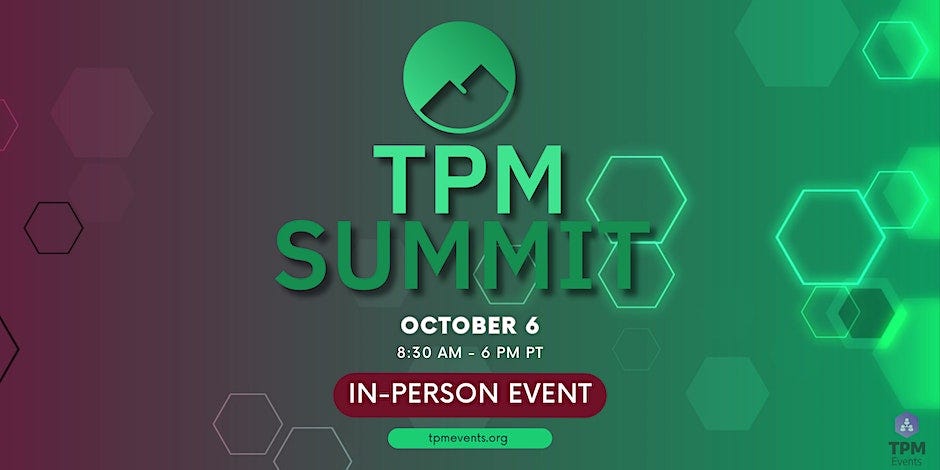A Dispatch On All Things Tools
Welcome to 📮Monday TPM Field Dispatch 014 - Short-form thoughts on tech program management + curated content for further exploration, delivered every Monday to your inbox to kickstart your week.
1.
Building timelines has been extremely frustrating and something I think about a lot lately.
A timeline is a series of interconnected stepping stones and milestones that outline a critical path that ends with a function, feature, project, or outcome delivered on a certain date or point. This timeline’s measure of time can be calendar time, engineering days, or even sprints.
Technical Program Managers, or Program Managers in general build a lot oftimelines. Projects we run take many months, quarters, years. Yet, the tools we have to build said timelines are not ideal.
Gantt charts require a certain level of “known” to be effective. They require an understanding of a start and end date for every task. By the time you need Gantt charts, Teams have moved closer to the tail end of the planning cycle thinking more in terms of resource, capacity, and delivery mode.
Using white boarding tools like figjam or Miro are cumbersome. Have you ever tried making micro adjustments to a schedule built in those tools. Sure you have the flexibility to move things around quickly, build thing quickly but the more quickly build the faster you get lost in the lines and alignment of the boxes and circles and labels.
You could build timelines in keynote or Google slides. Those who use slides know how painfully tedious it can be to maintain the timelines especially sharing and keeping track of changes over time. Forget the lack of infinite canvas, they make great presentations yet not for tracking a schedule overtime as work lands and things grow and expand.
To add to the misery, aligning the timeline with the issue management tool is another Everest. Atlassian, Asana, even Monday.com try to solve those by automating Gantt chart creation from issues. Yet, we know that issue management is not designed for freeform collaborative deep thinking without changing frame of thinking to delivery mode aka thinking in epics/child tasks.
BA 25/52: A Rorschach Test Or Why We Love to Hate JIRA
When you do get a timeline made, aligning with engineers on milestones and exit criteria is a different challenge. Engineers think in terms of task delivery rather than a linear timeline view. They either thinking in estimates or specific targets to shoot for.
Engineers default to making lists of tasks in Google doc or spreadsheets. Those tools have their own complications like ineffective dependency mapping and alignment.
There is a gap where exists the chaotic middle where the unknowns are too much for a Gantt chart yet enough is understood to go beyond basic starting milestones like scoping or design hand off to engineering.
We need better tools for conducting high-level planning especially when not all the details are figured out or defined that has the flexibility of building a timeline in figjam combined with the power of visualization of tasks.
A tool that allows:
A hardware program management team to build living hardware schedules.
A marketing team to develop timelines for the next GTM release.
A software PMO to layout the next few releases with milestones to understand interdependencies of the choices to work on different projects.
A design team to scope out ux, ui, and asset deliveries and collaborate with engineering to align their deliver schedule.
An engineering team to visualize and map out dependencies across multiple features to understand work breakdown against a timeline without building a full delivery schedule for each feature.
An operations team to layout the stepping stones to layout the deployment of a new vendor.
What if… all these teams could do all that in a single document and paint one hell of a program view for senior leadership to make the right call.
Is there room or need for such a tool in a TPMs arsenal?
👉🏽 What features or function would you want in this tool? Leave me a comment or reply to this email with your thoughts.
2.
I am obsessed with C4 Diagrams.
I have found the best way to communicate with engineers is make flowcharts and layout ideas on the whiteboard. The struggle I had was finding the right visual language to discuss these ideas and dig deeper into solutions.
Sequence diagram and lexicons like UML are not easy unless you were trained on them (both something I learned in my undergrad). These are also too low level to discuss abstract concepts.
I stumbled upon C4 diagram framework on hackernews and I am in LOVE.
It’s the perfect balance to start at the high level and dig deeper into the lower layers as you get closer to the solution or code. Created by Simon Brown, it’s the perfect visual language to discuss software architecture for TPMs and PMs. I have already done some concepts on past projects which a modeling framework like this would’ve been immensely helpful with. Simon offers workshops for developers but this might be useful for TPMs as well. Do check it out.
I might do a long post on this later.
3.
My heart aches for the near perfect All in one tool.
Recently, I was chatting with a CEO of an early growth startup in the app integrations space on tools. He asked me a simple question - if I built my own startup, what tool would I use to manage product development?
I thought long and hard before saying 37Signals Basecamp.
He was stunned at my answer expecting something along the lines of Linear or Asana or heck even Jira. But, my desire to use Basecamp comes from a point of exhaustion.
The great unbundling of software over the past decade has created this requirement to use many tools to operate even the most basic of product development organizations.
Slack for communication.
Linear or Jira for issue management.
Coda or Notion for wiki.
Figma or Miro for UI/UX, diagraming and whiteboarding.
Rarely do single conversations stay in a single tool. Some times I wish all of this could be one tool because the overhead for stitching and keeping conversations aligned is a maddening endeavor at times.
Perhaps if this question was asked to an engineer or designer the answer might be different and they may disagree with me.
I anticipate a great rebundling is upon us. What shape it might take is still unclear but you can bet it’s going to have generative AI in it for sure.
👉🏽 If you built your own startup, what tool would I use to manage product development? Leave a comment or reply to this email.
4.
We are few weeks away from the TPM Summit conference. 🎊 🎉 ❤️
It will be a mix of virtual and in-person at the venerable Computer History Museum in Mountain View, CA taking place on October 6th.
Huge kudos and extreme respect, admiration, and well wishes to the organizers behind this momentous event. I have always felt that the TPM community deserved and needed something like this.
🌝 I will be doing a talk at the conference titled “TPMs Are World Builders”.
🚨 For my readers only - use promo code AADIL4TPMS for 10% discount on the conference registration fees.
How was this week’s newsletter?
P.S.
🚨 Registration is now open for my next cohort on Oct 28 - 29.
🛒 Use promo code
BRFRIENDS40to get 40% discount on the course fees for my readers only.👉🏽 Sign up today as spots will be very limited for this cohort.
What does it take to Become A Great Technical Program Manager?
It took me years and many difficult projects at places like Apple, Google, Nike to understand what it means to be "Great".
😁 Good news for you, you won't have to spend years. Become a standout TPM in a few hours. Learn the skills and knowledge needed to gain senior leadership's trust to lead large cross-functional programs and take your career to the next level.
More real world examples.
More case studies.
More discussions.
More deep dive into topics like Systems Philosophy, Influence, Shape of Power, approaching complex technology and much more.
Now 2 Days long / 6-8 hours in total.
Rating: ⭐️ 8.6/10 (10 Reviews)
Course Fee: $899.
🚨 If you want to join my next cohort, 🚀 sign up for the waitlist here.
Read what people who have taken my course say:
A fantastic mix of tools, information, and real world examples to increase my understanding and capabilities. - Ryan Curry Technical Project Manager
This course had real life examples, great group of like minded professionals, and such insightful conversation. Best training I’ve had so far in this space. - Favour Okoh Sr. Technical Program Manager
Aadil is an excellent presenter and speaker, and the material he left us with was thought-provoking and actionable. I took so much value out of this class and can't wait to use this new toolkit to become better. I took so many screenshots of the slide deck, and I even printed out one of the slides to hang above my desk! - Michelle Andreana Technical Product Manager
If you enjoy and love reading what I write, perhaps you know someone who could also enjoy and love reading these essays and dispatches. Share this with your friends and colleagues and lets grow together. 🙏 ☺️ ❤️
You can suggest topics or questions for me to write about in the future. It could be something you are curious about or maybe something you're struggling with right now.






"My heart aches for the near perfect All in one tool."
And it always will, sorry :)
Think of the company and team you would have to assemble to do all of those things well. Holy Payroll costs, Batman.
This reminds me of a conversation I had with a CIO when I worked at a hospitality company. He was complaining about the fact that we needed eleven different point-of-sale systems to take in money. "After all," he said, "they all do the same thing: take in money."
You can see where this is going. The POS systems were built to take in money in a particular context. A table-service restaurant is going to have extraordinarily different needs than the kiosk renting kayaks. He was unconvinced. "It should be possible to do it."
My answer?
"Why hasn't someone done it already?" It's not an exotic, off-the-wall idea. So there must be a reason it doesn't already exist and it's because it would be waaaaay too hard to include all the contexts you need.
Sure email info@analyte.ca